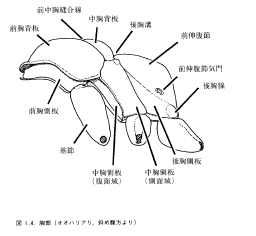5. Thorax
 As in other insects of the suborder Apocrita of the order Hymenoptera, the prothorax, mesothorax and metathorax of ants are closely linked to the first abdominal segment, to form a lump called the mesosoma, alitrunk or trunk. The term thorax used in the identification key encompasses these structures. That is, the thorax is composed of the pro-, meso- and metathorax as well as the first segment of the propodeum (the true abdomen). In worker ants, which have no wings, these structures are fused to each other and their border is often unclear.
As in other insects of the suborder Apocrita of the order Hymenoptera, the prothorax, mesothorax and metathorax of ants are closely linked to the first abdominal segment, to form a lump called the mesosoma, alitrunk or trunk. The term thorax used in the identification key encompasses these structures. That is, the thorax is composed of the pro-, meso- and metathorax as well as the first segment of the propodeum (the true abdomen). In worker ants, which have no wings, these structures are fused to each other and their border is often unclear.
Prothorax: The pronotum of the worker is relatively large. The right and left parts of the propleuron, covered with the pronotum, are joined in the center. The prosternum is pinched between the bases of the fore-leg coxae. The shape of the pronotum is often important for classification.
Mesothorax: In most workers, the mesonotum is fused to the mesopleuron. A remnant of the border between these two structures is sometimes seen as a depression or a suture line. In males and females, the mesonotum often covers the pronotum, and an oblique groove is sometimes seen in the mesonotum. The oblique line in the mesonotum is rarely seen in workers. Whether or not the promesonotal suture is evident is important for classification. The lateral and ventral aspects of the mesopleuron are lined by the frontal carina, which is markedly developed in some genera and often cover a part of the fore-leg coxa. The true sternum has degenerated and disappeared almost completely. A pair of processes are often seen between the mid-leg coxae on the ventral side of the mesonotum.
Metathorax: The metathorax of workers has degenerated more markedly than any other structure of the thorax. The dorsal aspect of the metathorax has fused to the propodeum and its distinction from the propodeum is almost impossible. A groove is often seen between the mesonotum and the propodeum on the dorsal side. This groove is the remnant of the metanotum and is called the metanotal groove. This is often used for classification. Ants usually have a swollen area called the metapleural gland lateral and ventral to the thorax. This gland has an opening at a point slightly dorsal to the hind-leg coxa. This organ is thought to excrete a fluid containing anti-fungal agents. This is one of the characteristics of ants. Some castes or species of ants have no such organ. The sternum in the metathorax has degenerated, like that in the mesothorax. Processes are sometimes seen in this area.
Propodeum: The propodeum is the first segment of the abdomen. It has no sternum but has an evident spiracle. The location of the spiracle often helps classification of ants. A pair of processes, called propodeal spine, are sometimes seen behind the posterior aspect of the propodeum. The shape of this structure is important for the identification of species.
Leg: The leg is composed, from basal to peripheral, of the coxa, the trochanter, the femur, the tibia and the tarsus. The tarsus can be subdivided into 5 segments and has a nail at its tip. The presence or absence of bristle on the lateral side of the tibia, the number of such hair, the number of tibial spurs, and the shape of the tarsal nail are important features for taxonomic purposes.
(Comments by Kazuo Ogata)